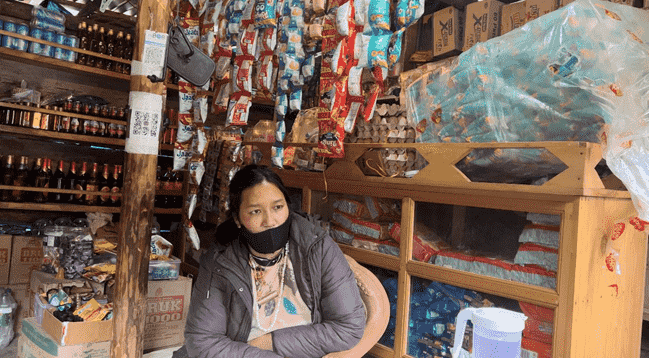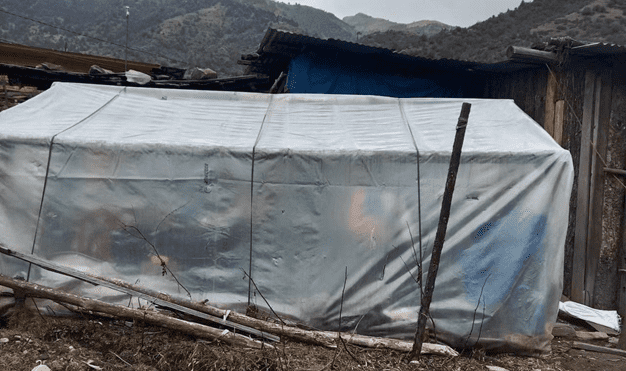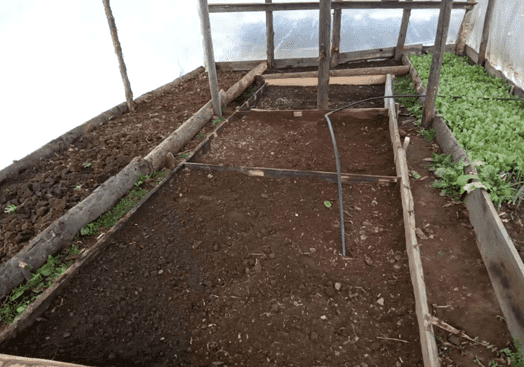In Merak, Bhutan, we meet Ms. Pema Wangmo, who, with the help of her community, worked to restore greenhouses destroyed by climate change-induced snow fall. This is the fifth of the “Voices from the Frontline (Phase III)” stories by GRP and ICCCAD supported by Irish Aid.
Ms. Wangmo comes from the Brokpa community, an indigenous group residing in the Merak Sakteng Villages within the Trashigang District of Bhutan. The village is situated at an elevation of 3,500 meters and is known as a highland area where the inhabitants are semi-nomadic yak herders. Despite being Bhutanese, the Brokpas have a distinct culture that sets them apart. They speak their own dialect called Brokpa Language and don’t wear the traditional Bhutanese attire. Instead, the men don Tshokan Chuba, a thick, red wool coat, and women wear Shingkha, a red and white striped dress.
The geographical area where the Brokpas reside is susceptible to various environmental factors due to its high altitude and remote location. This area experiences harsh weather conditions, including extreme cold, heavy snowfall, and landslides, which can disrupt their livelihoods as yak herders. This region was chosen to document how the impact of climate change factors on the Brokpas’ traditional way of life and their efforts to combat the issues.
Greenhouses in the village devastated by heavy winter snowfall
Ms Wangmo spent her entire life in the Merak village, nestled high up in the mountains of Bhutan. She witnessed many changes in her environment, but nothing prepared her for what happened in the winter of 2022. For the past two decades, the mountain caps around the village received less snow, but last year was different. The village experienced one of the heaviest snowfalls in recent history, which caught the inhabitants off-guard.
Ms Wangmo recounted how the heavy snowfall destroyed several community and individually-owned greenhouses in the village, including her own. She not only faced the challenges of being a single mother and caring for ageing parents but also the difficulties of being a shopkeeper in a remote highland village.
With the accumulation of snow on the roofs, there was danger of the roof collapsing and subsequent damage to the huts and goods inside. “I was filled with terror at the thought of the roof collapsing on my possessions and losing my source of income,” Ms. Pema Wangmo expressed. Her shop is an important source of income for her and her family. Clearing the snow from the roof of her shop was essential to ensure that the building was not damaged and her goods were safe.

The freezing temperatures also made it difficult for Ms. Wangmo and her family to leave their homes, especially her ageing parents, who need extra care and attention. The inaccessibility of resources due to their isolated settlement made collecting essentials such as food, water, and fuel even harder. She had to ration her supplies and make sure that her family had enough to last them until the weather improved.
The unprecedented freezing temperatures made it extremely difficult for her and her family to carry out daily activities. For instance, drying their clothes became a challenge since the below-freezing temperatures made it impossible to do so. She had to come up with creative solutions, such as using the heat from the stove to dry their clothes or hanging them near the fireplace. These experiences were challenging for Ms. Wangmo, as she had to balance caring for her family, running her business, and dealing with the harsh winter conditions.
Resilience in Action: Ms Wangmo’s determination to rebuild
Despite facing significant challenges due to the heavy snowfall, Ms Wangmo’s resilience and determination led her to take action. She not only cleared the snow from the roof of her shop but also repaired her greenhouse using wooden pillars and cellotape with the help of community members. “My neighbours and friends lended me their support in repairing my new greenhouse. They helped me with wooden pillars and building the greenhouse,” Ms. Pema Wangmo said. While this was a commendable effort, she acknowledged that the repaired greenhouse may not be as effective as the new greenhouses made from steel.

Therefore, Ms Wangmo’s proposal for improved infrastructure, communication networks in the area, and support to rebuild the community-owned greenhouses is crucial in building resilience and ensuring access to essential resources during extreme weather events. Climate change impacts are expected to worsen in the coming years, and rural communities like Merak may face even greater challenges. Therefore, it is essential to prioritise the needs of these communities and provide them with the necessary support and resources to adapt to climate change.

The story of Ms. Pema Wangmo and the Merak community offers valuable lessons on resilience, preparedness, adaptation, sustainability, and environmental protection in the face of climate change. Ms. Wangmo’s experience highlights the importance of indigenous knowledge and practices in responding to climate change impacts. Despite the uncertain future, there is hope in the community’s ability to adapt and innovate, as well as the efforts of organizations like Gross International Nature (GIN), which promote youth leadership and collaboration in environmentalism. To achieve a more sustainable and equitable future while preserving unique cultures and traditions, it is vital for individuals, communities, governments, and international organizations to prioritize climate action and support vulnerable communities. By working together and utilizing a range of approaches, we can overcome the challenges posed by climate change.
Interviewer’s perspective:
As an interviewer, I chose a representative of the Merak community most affected by climate change, and Ms. Pema Wangmo stood out as the most affected. Listening to her story was truly inspiring as her resilience and determination in such difficult circumstances were remarkable. Her experience underscores the significance of community support, innovation, and adaptation, something we all can learn when faced with climate change impacts.
About the interviewer:
Tshering Lhamo is a BSc Environmental Management Graduate from Bhutan. She co-founded Gross International Nature (GIN) with a team of like-minded youths from Bhutan, Bangladesh and Nepal. She aspires to promote youth leadership in environmentalism through advocacy, research and sustainable technology.
About the interviewee:
At the age of 34, Ms. Pema Wangmo is a divorced mother, farmer, and businesswoman who has not had the opportunity for formal education. She belongs to the Merak community in Bhutan, where she has experienced the severe effects of climate change, especially during the winter season. Despite these difficulties, Ms. Wangmo has demonstrated exceptional resilience and determination, proposing creative ideas to help her community adapt to the changing climate.





